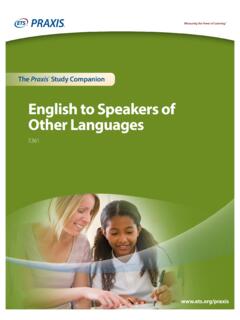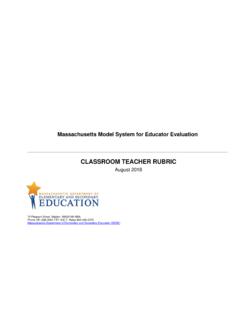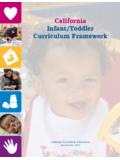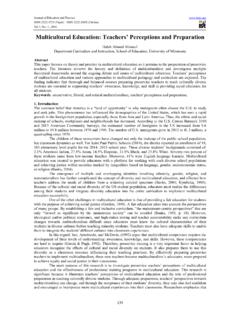Transcription of Teaching and Learning During COVID-19 and Beyond
1 Teaching and Learning During covid and BeyondThe COVID-19 pandemic is significantly impacting families, both in terms of their physical and mental well-being, as well as their financial stability. According to recent data from the American Psychological Association, parents are experiencing significantly high levels of As schooling has shifted online, children many of whom have spent months in social isolation, while families experienced both economic hardship and health distress are also being affected. High numbers of parents are reporting that their children are facing social and emotional health challenges, including loneliness, anxiety, and Many children are being exposed to varying levels of trauma that may undermine their sense of safety and stability, and have long term impacts on their daily lives, including their ability to engage in education has not met the challenge of addressing present educational needs, even under the best of In many cases, students are without devices or internet access; teachers lack experience with remote Learning ; parents do not have the additional time to devote towards their children s studies; or students simply did not show up Significant disparities exist in access to technology and broadband connectivity, which are further exacerbated across the urban-rural divide.
2 This is particularly evident among the most vulnerable students, many of whom required accommodations in ordinary times, including those with disabilities, in foster-care, or living in poverty. Furthermore, instructional capacity is an additional barrier impeding the transition to online Learning , both in terms of teacher preparation programs and as many school districts struggle to provide adequate guidance to teachers on instructional delivery and tracking participation and These factors contribute to Learning loss and further increase the risk that millions of students will have large gaps in educational attainment, impacting their preparation for a lifetime of Learning and employment. Preliminary research is already bearing this out. The average student could begin the next academic year having fallen behind academically by as much as of seven These losses are expected to be greater for minority and low-income children, further widening racial and socioeconomic achievement Black and Latinx students could experience Learning losses up to an equivalent of 10 schools look to reopen in the fall and work to transition students back into the classroom, they will face numerous challenges, including preparing school buildings to meet new state and federal health saftey guidelines, ensuring smaller class sizes, temperature checks, increased access to disinfectants, and personal protective equipment.
3 At the same time, administrators and teachers will need to catch students up, perhaps through reviewing skills and content that would have normally been covered During the previous academic year, investing in summer instructional programs, and opening early for students with special needs. Additionally, the social, emotional, and behavioral needs of many students will be greatly increased. Moreover, with schools not reopening uniformly and some parents uncomfortable with sending their children back to school before a vaccine is available, remote instruction will need to be strengthened. These new requirements will have to be addressed at a time of significantly shrinking budgets. Large majorities of parents, across all demographic groups, believe that schools should rethink how students learn, by developing innovative ways to teach children due to This crisis provides an opportunity for educators, communities, states, school districts, and the federal government to reexamine how students are educated and address all dynamics of Learning by integrating academic achievement with social and emotional Learning ; trauma-informed practices; and principles of motivation and engagement.
4 Isolation, disrupted routines, and ongoing uncertainty are highlighting the importance of emotional management, relationship building, and problem-solving. These critical skills can help students learn and cope with stress, instability, and trauma both while distance Learning and in a school setting. For additional information, contact: Kenneth Polishchuk 202-336-5945 The relationship among achievement, instruction, and social and emotional well-being is interactive Integrate social and emotional Learning (SEL), motivation and engagement, promoting a healthy schoolclimate, and resiliency training throughout all areas of the curricula and ensure these can be delivered in theevent of a transition to hybrid/abbreviated school days or virtual schooling Require teacher preparation programs to include instruction on SEL; culturally and linguistically responsiveteaching; fostering healthy social climates for Learning .
5 And to maintain the Higher Education Act s definitionof Teaching skills which is grounded in APA findings,viii and includes the ability to effectively teach socialand emotional skills, and support the social, emotional, and academic development of all students Increase existing or authorize new funding streams: For grants targeted towards SEL including During summer Learning programs to manageemotions; reinforce connections with and between students; establish and maintain positiverelationships; set and achieve goals; develop empathy for others; make responsible decisions; andsupport routines that create consistency For training educators, specified school personnel, and parents to develop knowledge and skillsrequired to understand and respond to the social, emotional, and personal development of would include how to develop meaningful online Learning experiences; create effective schooland classroom climates; reduce stress; and build students skills, such as resilience and agency To establish a pilot program for improving social and emotional health in schools by partnering withcommunity-based organizations to train teachers and administrators in social and emotional healthand Learning techniques Establish an interagency taskforce which must include teachers; parents with school-aged children; schoolofficials; psychologists; mental health and behavioral counselors; social workers; trauma-informed personnel;and behavioral intervention researchers to: Examine and recommend comprehensive benchmarks for policies, programs, and other issues relatedto successful approaches and best practices for improving social and emotional well-being;confidence, competence, and developmentally appropriate interpersonal aptitudes.
6 The ability to applydecision-making knowledge and thinking skills; and facilitate motivational skills Ensure culturally and linguistically responsive educational principles are embedded in expectationsfor all Teaching and Learning standards. This should include safe and supportive environments andschool climate for all students For online or distance Learning , support social-emotional well-being and Learning needs by: Using technology to meaningfully connect students to their schools Providing access to online social-emotional and mental health services; daily SEL and academicactivities developed by classroom teachers; and links to grade-appropriate external Learning resources Ensuring continuity of healthy student-educator and student-student relationships Sharing resources with parents/guardians on how to support students Learning remotelyTrauma-informed practices for Teaching and Learning Provide resources for schools to train educators and other school staff on the impact of adverse childhood experiences (ACEs) and traumatic experiences on children s health and development, and to implement trauma-informed practices, including for: Teaching , which may include trauma-informed approaches to managing student behavior and techniques for providing more agency to students Evidence-based mental health screenings and follow-up, including for ACEs, to be administered only by appropriately qualified mental health professionals Training for all school personnel, including school resource officers and security staff on ACEs.
7 Behavioral indicators of trauma; racial biases and how experiences of racism can be traumatic for students; and trauma-informed, non-punitive approaches to addressing challenging behaviors, discipline, and de-escalation Convene a taskforce to develop guidance for educators and administrators on culturally , developmentally, and linguistically appropriate training and responses to childhood trauma. The taskforce must study school districts around the country that have implemented trauma-informed approaches and provided systems of Learning and care for students who have experienced or are at risk of experiencing trauma or ACEs. The taskforce will identify, evaluate, and recommend a set of best practices and must consider several topics, including: Training on ACEs and their effects on Learning , behavior, and social and emotional health Trauma-informed approaches to attendance, Learning , and disciplinary policies culturally , developmentally, and linguistically appropriate services and resources for children and their parents or caregivers to prevent trauma and respond to reported adverse circumstances and unmet needs Professional development for teachers to ensure Learning continuity for in-person and virtual settings To institute more effective professional development, states and districts working with teachers, administrators, and institutions of higher education must identify competencies that educators are lacking and build sustainable, program-wide systems of professional Learning and Teaching , which provide opportunities for ongoing, timely, on-demand training on a variety of topics, including, but not limited to SEL.
8 culturally and linguistically responsive Teaching ; developing a healthy school climate; trauma-informed Teaching ; ACEs prevention and response; supporting unique learners; family engagement; implicit bias; and integrating technology. Such professional Learning activities should offer educators personalized Learning pathways that are contextual and translatable into practice Specifically, states and school districts should provide educators with ongoing professional development on how to conduct online Learning , including: Providing pre-service instructional training opportunities on how to use various technologies, tools, and platforms to build a sense of community, support social and emotional needs, and reinforce student agency and creativity Incorporating best practices for using technology for active Learning Providing specialized instruction, including on personalized Learning experiences, accommodations, modifications, and technical supports as appropriate for diverse learners, such as students with special needs, ESL students, etc.
9 I American Psychological Association. ( 2020). S tres s in America 2020: Stres s in t he Tim e of C OVID-19, V olum e One. R etrieved from ii American Enterprise Institute. ( 2020). H ow parents are navigating the pandemic: A comprehensive a nalysis of s urvey data. R etrieved from: -navigating-the-pandemic-a-comprehensive -analysis-of-survey-data/. iii Tawnell D. H obbs and Lee Hawkins, The Result s Are In f or R emot e L earning: It Didn t Work The Wal l Stree t Journal, J une 5, 2020. Retrieved from: 11591375078. iv Educators for Excellence. ( 2020). Voice s fr om the Virtua l Classr oom 2020: A Survey of America s Teachers on COVID-19 - Related Education Issues. R etrieved from: v Betheny Gross and Alice Opalka . ( 2020). T oo Many Schools Lea ve Learning to Chance D uring the Pandemic. C ente r on Reinventing Public Education, T he University of Washington. R etrieved from: -schools-leave - Learning -chance- During -pandemic; AASA , T he School Superintendents Association.
10 ( 2020). R epor t Of I nitia l Findings: COVI D Impac t On Public Schools. Retrieved from: (1)/AASA%20 covid %20survey%20 INITIAL%20032720% ; National Association of Elementary School Principals. ( 2020). N ational Survey of Principals Regarding COVID-19 . R etrieved fro m: vi Kuhfeld, M ega n, J ame s S oland, B eth Tarasawa, Angel a Johnson, Erik Ruzek, a nd Jing Liu. (2020). P rojecting the potentia l impact s of COVID-19 school closures on academic achievement. (EdWorkingPaper: 20-226) . R etrieved from Annenberg Institute at Brown University: ; Emma Dorn, Bryan Hancock, J immy Sarakatsannis, a nd Ellen Viruleg, COVID-19 a nd s tudent Learning in the United States: The hurt could last a lifetime McKinsey & Company, June 1, 2020. Retrieved from: vii Raj Chetty, John N. Friedman, Nathaniel Hendren, Michael Stepner, et al. (May 2020). Real-Time Economics: A New Platform to Track the Impacts of COVID-19 on People, Businesses, and Communities Using Private Sector Data.













